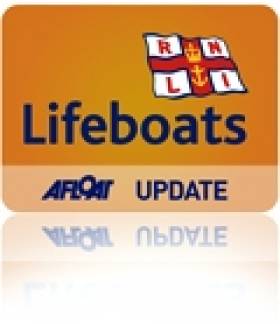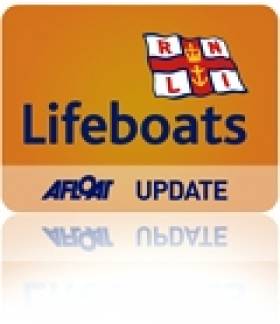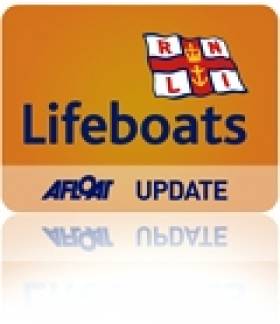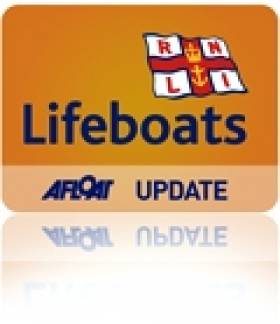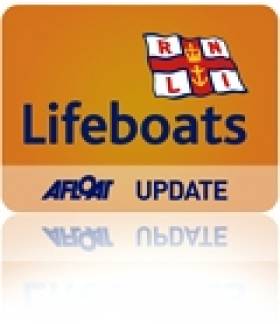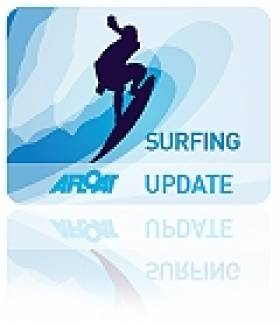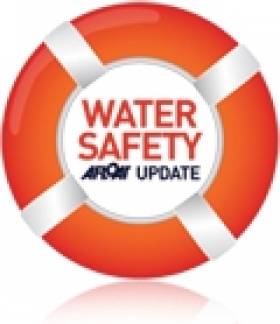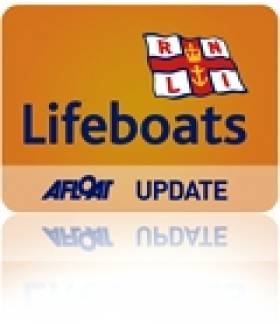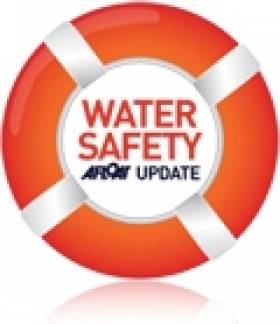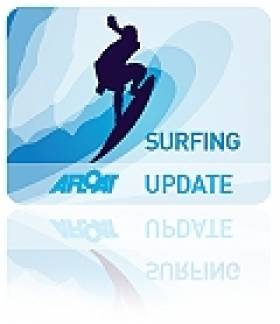Displaying items by tag: Bundoran
Bundoran Lifeboat Rescues Surfer In Difficulty
#RNLI - A surfer got into difficulty on Saturday evening (9 August) at Tullan Strand in Bundoran and was being swept out to sea when a member of the public spotted the situation and called the emergency services.
Two other surfers went to his aid while the pagers of the volunteer crew of the Bundoran lifeboat were set off at 6.05pm, five minutes later the lifeboat was in the water proceeding at full speed to the scene.
Arriving at Tullan Strand, the three surfers from Dublin were quickly located with the help of RNLI shore crew who had been deployed by land. The lifeboat took all three on board and proceeded back to the lifeboat station.
The casualty had taken on a lot of water and had oxygen administered to him on his return to the lifeboat station, where a waiting ambulance transferred him to Sligo General Hospital for further observation.
Bundoran RNLI volunteer crewman Brian Faulkner said: "Once again we are thankful to a member of the public who called the coastguard and made the alert.
"A lot more people are using the water in these good weather conditions and we’d like to remind everyone to be safe in the knowledge that if they do get into trouble in the water that we are on call 24 hours a day, seven days a week.
"Call 999 or 112 and ask for the coastguard if you see anyone in difficulty in the water or on the coast."
Meanwhile, a boat at anchor caused the volunteer crew of Bundoran RNLI to launch again yesterday evening (10 August) just after 8.30pm.
The boat had been spotted near Mermaid’s Cove at Mullaghmore with nobody on board and had caused concern, prompting the lifeboat to launch and check it out.
On reaching the scene, the crew of the lifeboat found that another boat had commenced towing the anchored boat. However, the towing boat had fouled its prop and they themselves then required assistance to get back to the harbour.
The lifeboat crew duly obliged and took the boat under tow and the four persons on board back to the harbour. The initial boat was also tied up.
"We were in the right place at the right time," said volunteer RNLI helm Kealan McNulty. "There was no immediate danger but we were happy to be on hand and help out."
Bundoran Lifeboat Launched To Family Trapped On Rocks
#RNLI - The volunteer crew of the Bundoran RNLI lifeboat were paged by Malin Head Coastguard yesterday afternoon (Wednesday 6 August) to a family of four who were trapped on rocks near Tullan Strand at the Co Donegal town.
A member of the public who heard the family calling for help phoned 112 to alert the Irish Coast Guard, who quickly paged the lifeboat at 5.49pm.
Within minutes of the alert, the Bundoran lifeboat launched and was quickly on scene. However, the water was too shallow to bring the boat closer to the family.
Shortly afterwards the Sligo-based coastguard helicopter Rescue 118 arrived, winching the family into the helicopter and lowering them onto the beach, where they were met by members of the RNLI shore crew.
"The situation may have been much worse had the member of the public not heard the shouts for help," said Bundoran RNLI helm Dessie Daly.
"We are thankful that they made the quick decision to call the emergency services and get us launched."
Baltimore Lifeboat Launches To Overturned Jetski
#RNLI - Bundoran RNLI launched to an overturned jetski on Saturday afternoon (2 August).
Just after 4pm, the volunteer lifeboat crew was paged by Malin Head Coast Guard to four people in the water off Murvagh Beach following the capsize of their jetski.
In overcast conditions, the lifeboat William Henry Liddington launched within six minutes of the initial request and made their way across Donegal Bay to the scene on the Rossnowlagh side of Murvagh.
The Sligo-based Irish Coast Guard helicopter Rescue 118 also launched to the scene.
Upon arrival, the RNLI crew found that the family of four from Northern Ireland had made their way safely to shore. A member of the crew went ashore to ensure that the family were okay.
"Thankfully the family were wearing lifejackets, otherwise this could have been a much more serious situation," said Bundoran RNLI helm Brian Gillespie.
"We would remind sea and water users to always wear a lifejacket when heading for the water and as always if a member of the public sees someone in danger on the water to call 999 or 112 and ask for the coastguard."
Bundoran RNLI Commemorates 40 Years Since Tragic Drowning
#RNLI - This Sunday 3 August, members of the Kerrigan family, their friends and neighbours, the emergency services and the general public will gather at 10pm for a special function in Dorrian’s Imperial Hotel in Ballyshannon.
Following the annual blessing of the boats ceremony at the Mall Quay at 7pm, the Indians will perform at Dorrian's marking 40 years since Danny Kerrigan’s tragic drowning and subsequently the establishment of a marine rescue service in the area which became Bundoran RNLI.
The band is kindly sponsored by the Kerrigan family of Ballyshannon, whose brother Danny, a signals NCO at Finner Camp, drowned in 1974 at Roguey Cliffs.
Despite Danny's great efforts to stay afloat in heavy seas, there was no emergency boat available in the area and no other boat could get to the scene in time to save him.
As a result of his tragic death, a meeting brought together members of the Defence Forces, Gardaí, Fire Brigade and water safety interests in the area, the result of which was the formation of the Bundoran Rescue Committee.
Completely new to the area of water safety, they sought the advice of water safety interests from Tramore in Co Waterford. Following consultation and an assessment of the local area, it was decided to launch the new service from the West End pier.
Funds were raised in the locality and a second hand 'D' class inflatable boat was purchased from the RNLI. The boat was initially stored in sheds in Bundoran up until the committee, with the support of many local people, built the first rescue boathouse on the pier.
Subsequently the service has saved many lives in Donegal Bay, including the Mountbatten incident off Mullaghmore in 1979. The RNLI took over the running of the service in 1994.
The lifeboat crew today are as they were 40 years ago – volunteers – and rely on the generosity of members of the public and their constant donations in order to keep this lifesaving service operational in Donegal Bay.
Lifeboat operations manager for Bundoran RNLI, Tony McGowan, said: "We are indebted to the Kerrigan family for organising the function and generously donating the proceeds to the lifeboat and we take the opportunity on the night to remember Danny and all of those who have been lost at sea in the area."
The Kerrigan family added: "While it was devastating to lose Danny, it was good to see a lifeboat service formed as a result and our thanks go to the present lifeboat crew for all their great work.”
Tickets for the night are available on the door at €15 or in advance from the Kerrigan family, McNern Barbers in Ballyshannon or BMG Hardware in Bundoran.
A history in words and pictures of Bundoran Lifeboat Station is available on the station’s Facebook page.
Bundoran Lifeboat Helps Six Teenagers Trapped By Tide
#RNLI - Last night (17 July) the volunteer crew of the Bundoran RNLI lifeboat were paged by Malin Head Coast Guard to the aid of six teenagers who had been cut off by the tide at the West End of the Co Donegal town.
Bundoran's lifeboat William Henry Liddington launched just after 8.30pm with four crew on board and were on the scene within two minutes to find the group, who had climbed down to the water’s edge but were unable to make their way back and became trapped by the tide.
The six, none of whom were injured, were helped on board by the lifeboat crew and brought safely back to the station, where they thanked the crew.
Helming the lifeboat on the callout was Dessie Daly, who said: "This was another callout that had a happy ending.
"We thank the member of the public who made the initial emergency call and remind anyone who sees anyone in danger on the coast to call 999 or 112 and don’t assume that somebody else has done it."
#Surfing - Organisers of the 2014 Sea Sessions Surf and Music Festival have just announced details of their programme for 27-29 June.
Joining a number of top music acts will be some of the best competitors on the international circuit for Ireland’s 'biggest beach party of the year', which proved a big draw to the Donegal surfing hotspot last year.
The Sea Sessions Expression Session is returning in 2014 with the cream of European performance surfing taking on the best in Ireland.
The event format as usual is 'best move/air' and is organised in a way to allow the surfers to express themselves and push their performance.
“It is a really spectator-friendly format”, said organiser Pete Craig. “Most surf events are quote technical and not really that engaging for non-surfers. This unique format allows for and encourages explosive surfing that everyone can get.”
The competitors will hail from places such as France, Spain, Portugal, the Caribbean, the UK and Ireland.
William Alotti (Saint Martin) is returning to defend his title and is an early favourite. Toby Donachie (UK), who was one of the standout performers last year with some huge boosts, is also returning to challenge Alotti for a total prize pot of €3000.
Noah Lane (AUS) was the dark horse of the event last year, and after having settled in Bundoran, he may have some local knowledge that could aid him this year.
New for 2014 is the Malin Waters Fish Challenge, which will see a selection of local surfers and traveling pros attack the waves in some old-school shapes that have been selected for the event.
On the music side, top international talent will be joining the crème de la crème of Irish acts this year at Sea Sessions with Kelis, The Strypes and The Dandy Warhols all set to perform in Bundoran.
The full music line-up and festive activities can be found at www.SeaSessions.com.
#WaterSafety - The crew of Bundoran RNLI's lifeboat, together with local fishermen and members of Irish Water Safety, recently welcomed a group of students from Lucan, Co Dublin who created a new school’s guide to water safety in Ireland’s rivers, lakes and seas.
The group of students from St Joseph’s College in Lucan are participating in the 2014 Young Social Innovators programme and were tasked with picking an issue of concern in their local area and to take action to change it for the better.
They decided to tackle the ongoing problem of drowning, particularly after the tragic summer last year when so many young people lost their lives needlessly during the hot spell.
Their vision for the information pack is to “think before you splash” – encouraging young people to become more involved in water activities and to increase their awareness of the water.
The pack consists of a lesson plan for teachers as well as a local ecology & water safety survey, 10 water safety rules and more.
Speaking during the visit, Bundoran RNLI crewmember Killian O’Kelly said: "It’s heartening for us who volunteer to save lives at sea to see this initiative being undertaken so enthusiastically by this group of students – they are to be commended for such an excellent piece of work and if it helps to save one life this summer then it’s time well spent."
The group hope to make the booklet available online in the coming weeks.
Bundoran Lifeboat Called To Assist Pleasure Craft At Mullaghmore
#RNLI - The crew of Bundoran RNLI were tasked yesterday afternoon (19 January) for their first call out of 2014, to an 18ft pleasure craft with two people on board which suffered engine failure off Mullaghmore Head in Co Sligo.
The alarm was raised with Malin Head Coast Guard shortly before 4pm by mobile phone and the lifeboat launched within three minutes, as many of the crew were already on station completing their Advanced Cardiac First Responder course.
On arriving at the scene, the volunteer crew found that the occupiers of the pleasure craft were being assisted by local charter fishing boats. The Bundoran lifeboat crew then took the craft under tow to Mullaghmore harbour and returned then to the lifeboat station.
Speaking afterwards, Bundoran RNLI deputy launching authority Patrick O'Doherty said: "We were happy to assist the boat owners who had the misfortune of having their engine lose power while out on a Sunday afternoon.
"We would advise all boat owners to ensure that they have a means of contacting the coastguard in case of emergency when out on the water. We would especially recommend the use of a handheld VHF radio which also allows our equipment on the lifeboat to locate a signal quickly."
Bundoran RNLI Urges Safety Over The Christmas Break
#Safety - Bundoran RNLI is among those urging water users to exercise common sense and safety over the current holiday period as persistent stormy weather makes sea conditions treacherous around the Irish coast.
With water hobby gifts like surfboards, bodyboards and kayaks a certainty under the tree on the 25th, the RNLI advises that all usual safety checks should be performed before heading out into the water.
If you are using equipment for the first time, make sure you know how to operate it correctly and most of all take a sensible approach when using this equipment in the water.
Check the weather forecast, check the conditions of the beach or water areas you are in and if you are unsure, seek the advice of a local surf school or coastguard who will be happy to advise you of any imminent or hidden dangers.
Bundoran RNLI lifeboat operations manager Tony McGowan adds: "We want people to enjoy the holidays and any new sporting gifts they receive for Christmas but of course we also want people to be safe and come back in one piece if they venture into the water.
"The lifeboat will as usual be on standby 24/7 over the holiday period and will be ready to launch if requested."
As the end of the year draws close, all of the crew of Bundoran RNLI wish to thank each and every supporter who has contributed to the charity this year for their generous donations.
Volunteer lifeboat press officer Shane Smyth says: "It’s been a busy year for our fundraising teams with big events like the annual Dinner Dance, the Soapbox Race, the Station to Station Challenge and of course the Boat Push.
"Thanks to all of our supporters and our fundraisers who work quietly in the background. Your help to keep us running is very much appreciated. We’d like to wish you all a very happy Christmas and a happy and safe 2014."
Tickets are now on sale for the annual dinner dance which takes place at the Great Northern Hotel on Friday 31 January 2014 with entertainment from Derek Ryan.
Bundoran Named One Of 'World's Coolest Surfing Towns'
#Surfing - When it comes to the world's coolest surfing destinations, Bundoran makes the grade yet again - according to Travel+Leisure magazine.
Nearly 18 months after the Donegal location was named one of the best surfing towns in the world by National Geographic, the big wave hotspot - site of the deciding leg in the 2012 Irish Championships surfing tour - has been included in Travel+Leisure's list of the 'World's Coolest Surf Towns'.
Indeed, Bundoran's listed along with 15 other renowned surf pilgrimage sites such as Encinitas in California, Australia's Byron Bay, Jeffreys Bay in South Africa and Hawaii's Paia and Haleiwa.
"Passion for pubs, music, and surf culture collides" in Bundoran, the magazine says, highlighting the town's three-time hosting of the European Surfing Championships and reputation for rock-band jams "into the wee hours at bars like Chasin' Bull", not to mention the "lively conservation" at Brennan's Criterion, an institution for more than a century.
The accolade for Bundoran comes just a few months after Mullaghmore Head, a little further along the northwest coast in Co Sligo, was named one of USA Today's 'World's Most Surprising Surf Spots'.
And it will surely be good news for Irish tourism chiefs who've recently launched a drive to attract more surfing enthusiasts to our shores, particularly over the quality winter surfing season.




























